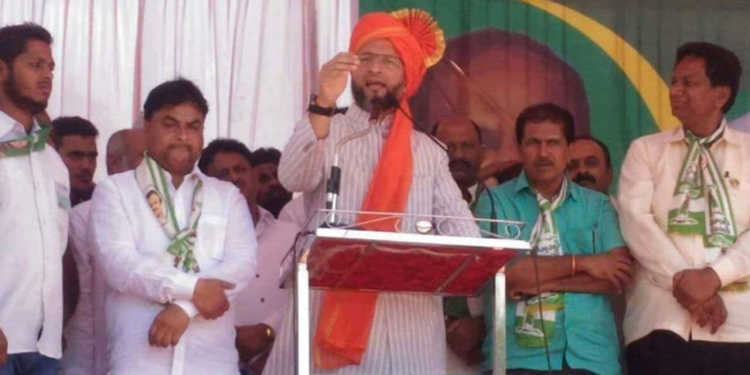Karnataka elections are going to be held in a couple of days, on the 12th of May to be exact. Campaigning for the Karnataka state elections will end today and with it will end the speeches and rallies of the political leaders to influence the public. Campaigns of political parties in Karnataka was a full blown affair, PM Modi’s rally showed that BJP does have a foothold in the state, while Congress had to call in Sonia Gandhi at the last moment in order to take care of the damage done0 by Rahul Gandhi and his counterparts in the state.
As predicted by most of the pre-poll surveys, Janata Dal (Secular) might play the role of a Kingmaker in Karnataka after the elections. Janta Dal (S) has been trying hard to increase its chances of winning maximum seats in the elections and so it chose to rope in Asaduddin Owaisi to campaign for its candidates. Owaisi’s, All India Majlis-e-Ittehadul Muslimeen (AIMIM) is not participating in the elections. Owaisi however, was roped in by Janta Dal (S), to campaign for its candidate from Belgaum. Janta Dal (S) believes that Owaisi’s support could induce the Muslim community to vote for Janta Dal (S).
Crowd at the rally and the media personnel were in for a shock, when Owaisi came on to the stage wearing a saffron turban. Owaisi attacked Congress and Siddaramaiah from the stage while he called out to the people to vote for regional parties like Janta Dal (S) which has the potential to challenge PM Modi.
Asaduddin Owaisi and his divisive politics are nothing new for the Indian masses. AIMIM was revived by Owaisi’s grandfather in Hyderabad and it was able to win seats for the Muslim-majority in Hyderabad. The political family of Owaisi has always maintained a pro-Muslim and anti-Hindu image. Owaisi’s own younger brother Akbaruddin Owaisi has again given out anti-Hindu speeches at rallies in Hyderabad. Making fun of Hindu gods and goddesses, threatening to kill Hindus and inflammatory comments against political leaders are his forte.
Asaduddin Owaisi might not be as vocal as his younger brother but his intentions are not any different. This can be deduced from the fact that AIMIM till date has fielded candidates across India only from those constituencies which have a sizeable muslim population. Owaisi knew that the only support he could get was from the disillusioned masses that do not separate politics from religion.
It is therefore a big deal when AIMIM president and MP from Hyderabad, Asaduddin Owaisi comes to attend a rally wearing a saffron turban. References to the colour saffron and its association with the Hindu religion and BJP have many a times been used by Owaisi in a derogatory way. For him to wear a saffron turban means that Indian politics is changing for better. Asaduddin Owaisi’s saffron turban points towards a change in the mindset of people who are no more amused by divisive politics anymore.
Muslims have been used as a vote bank in India for far too long, from Iftar parties to non-Muslim leaders of political parties wearing skullcaps in order to appear secular. This appeasement was put to rest by PM Narendra Modi, who stopped the tradition of attending Iftar parties before every Eid. PM Modi chose to work for all the people of India rather than try to please them. PM Modi’s resistance to the skullcap on stage during the pre-election campaigns of 2014 was also a huge step towards ending religious appeasement in the political scene of India.
The trickle-down effect from the Centre happened slowly but it definitely did. Mayawati and Akhilesh Yadav lost Uttar Pradesh inspite of being leaders of scheduled caste and OBC communities respectively. Lalu Prasad Yadav and his party lost in Bihar, inspite of Lalu Prasad being the champion of caste based politics. The biggest turn around came when Congress President Rahul Gandhi started visiting temples before state elections. Rahul Gandhi had to finally visit Hindu temple in order to prove he was not a communal leader. Asaduddin Owaisi’s saffron turban is a follow up to the acts of Congress and other left winger parties. Who would have known that the Congress and castist parties would have been sidelined by the people of India from 2014 onwards? Owaisi realizes that people have seen through the game of religious politics and it cannot be used anymore to fool people.
Owaisi’s Bhagwa turban marks the symbolic end of minority vote bank myth in India. His saffron turban is a desperate attempt to change his image and that of AIMIM. Communal politics of the pseudo-secular parties will come to an end really soon and Owaisi is just the beginning.
It can surely be called as the first acceptance of inclusive politics by openly communal parties. Congress has miserably tried to revamp its image of being pro-masses rather than being selectively pro-community. Owaisi’s and his party’s destiny will be decided in the future. The voters of India will decide whether they are ready to forgive hate and fear mongering parties or not.
After all voters are what Owaisi and his ilk aim to please, with no regard to the harm caused to the social fabric of the nation because of their divisive political strategies and communal tone of speeches.


































